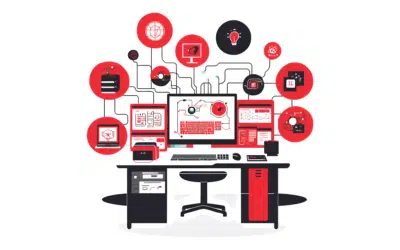The amount of data created is growing rapidly and it is expected that in 2020 we will create a minimum of 40 trillion gigabytes; 40 percent of all this data is expected to come from sensors or machine-to-machine data. All of this data will significantly impact global industries, from creating tailored medicines to reducing our global carbon footprint. There is an impact of big data on many different industries, so let’s have a look at four important industries and how they are affected by big data:
Healthcare
Healthcare is quickly becoming a digitized industry generating immense amounts of data that can be analyzed to improve our health. If a fully sequenced human genome accounts for 100 gigabytes of raw data at minimum, it is clear that the healthcare industry will generate massive amounts of data in the coming years. All that data can be explored to develop tailored medicines, improve treatments and reduce fraudulent behaviors.
According to Price Waterhouse Coopers (PwC), counterfeit, wasteful and illegal behavior accounts for an estimated third of the $2.2 trillion spent on healthcare in the United States each year, so there is a lot to win by analyzing data. But big data, of course, does more than just reduce risks of fraudulent behaviors, it can also help improve patient care and the entire patient experience when in hospital—those are welcome benefits of all that data.
For example, hospitals that provide nurses, doctors and patients with RFID-enabled chips by embedding them in the patient’s or doctor’s card, will be able to better and more efficiently manage the healthcare experience. Such sensors can provide insight into the relationship between patient satisfaction and the amount of time a doctor or nurse spent with the patient. It can also show how far the nurses and doctors have to walk across the hospital to care for their patients and whether relocating various departments can minimize travel time and optimize usage of expensive equipment. The potential of big data is enormous, but it will also require substantial investments, time and energy in the coming decades.
Energy sector
Since the invention of the steam engine in the 17th century, we have created networks that provide electricity to 75 percent of the world. With the improved technology of today and the massive amounts of data being created we can now move to the next phase in the evolution of energy. Big data can change an existing old energy network into a smart network that understands energy consumption, down to the individual.
Sensors in the energy industry will drive the revolution in how the world’s energy is created, monitored and delivered to homes and offices. The smart grid will enable bidirectional communication with smart meters, energy companies and other in-home appliances. The Internet of Things will enable devices to talk to each other, and also talk to your local energy company. This will help energy companies manage the utilization across the network. This is especially important when electric cars become mainstream. If all households start charging their electric car at the same time, the energy grid might not be able to cope with the peak demand. Therefore, regulation of the energy usage is required, which, on the other hand, will also create ethical questions: what if you are a doctor and need to go to a patient, but your energy company decided to charge your car a few hours later?
Battelle’s Pacific Northwest Smart Grid Demonstration Project is a pilot smart grid, across five states with 60,000 participants. The objective of the project is to understand whether smart grids are as valuable as we think and whether they even make sense economically, as substantial investments in software and hardware are required. One thing is for sure, smart meters that measure at short intervals will drastically increase the amount of data created, but all this data can have a big impact on the energy sector and even have the potential to reduce our carbon footprint.
Telecom industry
If they want, telecom organizations can know absolutely everything about their customers, including where they were when, with whom they connect frequently, what their daily habits are and more. This is due to the growing number of call detail records, location data, social media data and network traffic data. Especially in Europe, the telecom industry is required to retain data on their customers for six months and up to two years. As a result, and because of the mobile revolution, the global telecom industry has experienced a massive growth in data.
There are ample opportunities for telecom organizations to benefit from this data. The telecom organizations that make use of all that data are able to outperform their peers, improve their bottom lines and grow their market share. The data from the network, generated by the users as well as sensors in the network, can help them to optimize their networks that automatically adapt to fluctuating demands across time and space.
Or what about reducing churn rates? Especially in the telecom sector, the competition is fierce and customers are easily moving to another provider. Customer data can inform providers whether a user is experiencing a growing amount of dropped calls, and therefore might decide to move to another provider. Or monitoring the sentiment of its customers and especially its influencers can inform the provider about the likelihood among its customers to switch. By doing such analysis, T-Mobile USA managed toreduce their churn rate by 50 percent in one quarter
Consumer goods industry
Of course, the consumer goods industry will also be changed drastically thanks to big data. Apart from getting to know your customers more intimately and being able to generate “segments of one,” big data offers a lot more opportunities from optimizing the inventory to monitoring prices of raw materials.
Data from the Point-of-Sale (POS) systems at retailers can provide extremely valuable information to manufacturers if they have real-time access to this data. If POS systems become connected, it is possible to have real-time insights in sales data from all over the world, down to the individual store level. This data can show peaks and decreases in demand and when linked to public and social data it can help to predict the demand for different products at different locations at different times. Algorithms can automatically detect anomalies and warn the head office if an action is required. The effect of changes in pricing as well as marketing campaigns can be noticed in real-time, giving marketing teams the possibility to make changes instantly if the outcome is not as expected.
Prices in (raw) materials fluctuate constantly. Using big data analyses, companies can predict upcoming possible price fluctuations and adjust purchases accordingly. These price fluctuations can be predicted by following important parameters around the world that have an affect on the price such as market data and weather data. When these data sets are combined, predictive analytics can forecast price volatilities, demand or shortages.
As can be seen from these four examples, big data is going to change any industry and any organization. Companies that want to survive in this competing world therefore should start developing a big data strategy, as it is not the strongest of the organizations that survives, nor the most intelligent—it is the one that is the most adaptable to change.








